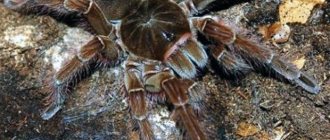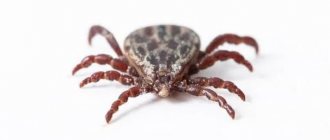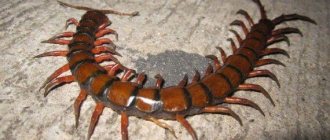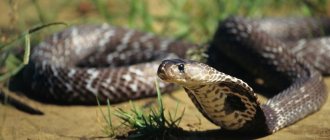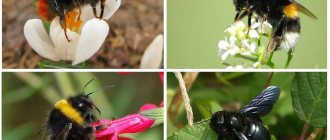Tarantulas are large, poisonous wolf spiders. This means that the animal hunts, unlike its relatives, most of which feed on prey caught in trapping nets. He needs the web only for arranging the nest.
For food it catches insects and small vertebrates, which it kills with poison. Tarantula bites of any kind are poisonous, so in this case a person experiences quite strong and unpleasant sensations, and some may develop an extremely violent allergic reaction.
Large spider of the genus Tarantula
Why is it dangerous for humans?
Is tarantula venom dangerous for people, arachnologists explain. They claim that it is quite safe for a healthy person. But still, attempts to disturb the spider lead to the release of protective needle-like hairs.
For the skin and mucous membranes, they act as foreign bodies. They can cause degranulation of mast cells and an anaphylactoid reaction (urticaria, a sharp decrease in blood pressure, bronchospasm, Quincke's edema).
For a person with allergies, a tarantula bite poses a serious danger. Pregnant women and children are also at particular risk. And in the case of other adults and healthy people, it is no worse than a wasp sting.
Dzungarian tarantula
The South Russian or Dzungarian tarantula is common in the Caucasus, Central Asia, and southern Ukraine. Here it can be found in the steppes, in floodplain meadows near rivers.
When viewed from the front, the Dzungarian tarantula is quite cute and resembles a fairy-tale gnome. In a calm state, its front legs are lowered and a large streamlined head part of the body is visible, below is a transverse strip of short hairs, reminiscent of a short whisker brush; under it there is thick, longer hair, similar to a goatee, and above there are 2 large and under them 4 smaller eyes
Just a cartoon character! But if suddenly someone had the imprudence to disturb it, the picture changes radically: the spider raises its front legs high above its head, taking a threatening pose. Now he no longer looks like the sweetest creature
He's ready to attack!
The tarantula's vision is excellent. The spider has 8 eyes located at the cephalothorax end. 4 of them are shiny and clearly visible, and 4 are duller. The spider's 8 large legs, widely spaced in all directions, are covered with long black hairs. The poisonous apparatus of the tarantula is located on the sides of the anterior section of the cephalothorax and consists of two glands, the ducts of which end at the sharp ends of the strong jaws.
Signs of a bite
If a tarantula has bitten a person, it will not be possible to avoid soft tissue swelling, hyperemia and local pain. Puncture marks remain on the damaged area.
They rarely bleed, but often take a long time to heal. Other manifestations and symptoms of a human bite include: burning, itching, local fever, acute inflammatory process.
If the following symptoms appear, a person should not delay visiting a doctor::
- nausea;
- violation of spatial orientation;
- breathing problems;
- severe tachycardia, arrhythmia;
- a sharp decrease in blood pressure;
- loss of consciousness.
Severe allergies to arachnid venom occur less frequently than with bee stings. However, if acute reactions develop, there is a high risk of anaphylactic shock and sudden death after a bite from this arthropod.
Snakes
The only poisonous snake in Crimea, the steppe viper, lives in the steppe part of the peninsula and on the Kerch Peninsula.
Occasionally visits the foothills. The steppe viper is not found on the southern coast. The venomous viper is easy to distinguish from other snakes. She has a dark stripe on her back and a triangular head.
The character of the viper corresponds to its name: the snake is extremely unfriendly and vicious. She avoids humans and bites only if she is in danger. In Crimea, there are no known cases of death from steppe viper bites.
“Acquaintance” with a non-venomous grass snake or copperhead is much more likely than with a viper. Sometimes there is a yellow-bellied snake, which is not a snake at all, but a legless lizard, non-poisonous and extremely useful. But if you are walking in a noisy group, be sure that all the snakes and other living creatures have long fled: they are more afraid of you than you are of them.
If misfortune does happen - a viper stings a person - you must immediately put something cold on the bite site. It is useless to cauterize or cut the affected area. You cannot knead the skin at the site of the bite: it can cause infection. The victim needs to drink plenty of fluids (not alcoholic drinks! Alcohol fixes the poison in the cells!) The bite is more dangerous the closer to the head. A tourniquet cannot be applied. Recent research by doctors has shown that applying a tourniquet is not only ineffective, but also increases the strength of the poison in the body. The victim must be taken to a medical facility as soon as possible. The most effective remedy for snake bites is antivenom serum. It is administered intramuscularly, preferably no later than half an hour after the snake bite. Pain, swelling, and fever usually go away after a few days, but it happens that the disease drags on.
The ringed scolopendra is an insect of the millipede class. It secretes a powerful poison, but its bite is not fatal to humans.
The length of the centipede is about 10 cm. It is nocturnal, hunts for small insects, and sometimes attacks lizards. During the day it hides under stones, logs, and in rock cracks. Scolopendra often crawls into tents when the canopy is left open at night.
The bite of a scolopendra is difficult for humans to bear. The pain is like a bee sting, the bite site becomes very swollen, and the temperature rises. Later, chills and malaise begin. These painful phenomena continue for 2 days, after which the temperature subsides and the tumor quickly resolves. The bite of the ringed scolopendra does not cause any dangerous complications.
First aid for a bite
Any person should know what to do if bitten by a tarantula. The procedure for attacking such a spider is similar to first aid for an insect attack. The average person without hypersensitivity to tarantula venom can get by completely without any special care.
But most often, first aid for a bite includes the following::
- the damaged area is washed with warm water and antibacterial soap. If the latter is absent, then any toilet soap will do, but try not to rub the bite area too much.
- After thoroughly washing the bitten area, it is treated with an antiseptic (Chlorhexidine, Miramistin).
- Cold is applied to the pathological lesion. To do this, use ice or a bottle of ice water. Cold is applied for 10 minutes, then a break is taken and the manipulation is repeated again. Repeat cooling until the pain completely subsides.
- In order to reduce swelling, raise the bitten part of the body and hold it in this position. They try to remain calm throughout the entire period.
- The victim tries to drink more fluids. Thanks to this, toxins are eliminated from the body faster.
- If a person has symptoms of an allergic reaction, then take an antihistamine.
If a tarantula has bitten a small child, a person with a weakened immune system or an allergy sufferer, or if the victim’s health is rapidly deteriorating, then seek medical help immediately.
Description of the spider
Appearance
The tarantula belongs to the phylum arthropods, the class arachnids.
Its furry body consists of two parts - the cephalothorax and abdomen. On top of the spider’s cephalothorax are 8 eyes, which give it the ability to view its surroundings at 360 degrees. The color of tarantulas is mainly brown or black with reddish spots and stripes.
Based on size, all types of tarantulas are divided into small, medium and large. In America, spiders up to 10 cm in size live, their paw span is up to 30 cm. European relatives of the tarantula are much smaller than their American counterparts. Females reach a size of 4.5 cm (with a paw span of up to 8 cm), males are somewhat smaller and are rarely larger than 2.5 cm.
Spider's home
Tarantulas live in burrows, which they dig for themselves. Spiders choose their burrow location very carefully. One of the prerequisites must be the presence of a body of water nearby. The depth of the hole is on average 50–60 cm.
The tarantula weaves a web around the walls inside the hole and, by its vibration, determines what is happening on the surface.
Before wintering in colder regions, tarantulas deepen the hole to 1 m and clog the entrance with leaves entwined with cobwebs.
Reproduction
Male tarantulas reach sexual maturity by the end of summer and during this period they look for opportunities
mate with a female. This is a very risky undertaking, since often young tarantulas lose their vigilance and, instead of an act of love, can simply be eaten by the female. Having discovered a female, the male tarantula begins to vibrate its abdomen and actively move its front legs. These actions allow the pauhiche to correctly determine the species of the male.
If the female is ready to mate, she begins to repeat the movements of the male. After mating, the male must quickly leave, otherwise the excited female may simply eat her sluggish partner.
The fertilized female hibernates in her burrow for the winter. In the spring, with the arrival of the first warm days, the female tarantula crawls to the surface and exposes her abdomen to the sun. This promotes the formation of eggs in the spider's body. When the eggs mature, the female weaves a web where she lays her eggs. Depending on the type of tarantula, there are from 200 to 700 eggs (on average 300–400).
Next, the female forms a cocoon from the web with the laid eggs, which she rivets to her body. The spider walks with this cocoon until the spiderlings begin to move inside the cocoon. The spider gnaws the cocoon and helps them crawl out. Immediately after birth, the spiderlings climb onto their mother and settle there in several layers. The spider carries her babies on her until they begin to feed on their own.
When the babies grow up, the mother begins a journey, during which she gradually throws off the spiderlings. In this way, she resettles the younger generation.
What do they eat?
Tarantulas feed on insects and animals that are not larger than them. The spider lies in wait for its prey not far from the hole, pulls it inside and has lunch there. Tarantulas eat their prey in a very unique way. They bite into an insect or animal and inject a poisonous liquid into it, which dissolves all the insides of the victim. After this, the spider simply sucks out all the contents.
What not to do
The following should be avoided after a person has been bitten by a tarantula::
- cauterize the damaged area. Toxicologists point out that this method is not only ineffective, but can also be harmful.
- Dissect the pathological area. Such manipulation leads to infection and a general deterioration in the person’s condition.
- Rub or scratch the wound. This is also fraught with the addition of a secondary infection.
If the injured person’s condition worsens sharply, you should not hesitate to call an ambulance.
Population and species status
The greatest distribution of these arthropods is associated with forest-steppe, steppe and desert zones. Their total numbers have been steadily decreasing until the last ten years, when the process of population decline has slowed down significantly. Experts believe that this was facilitated by the general warming of the climate on our planet.
Commercial activities cause significant harm to tarantula populations. These arachnids are caught in third world countries and sold for little money in order to somehow survive in difficult conditions. Therefore, in countries where the economy is very weak, the number of tarantulas is constantly decreasing.
Human activity is causing serious damage to spider populations in countries such as Bolivia and Brazil. Due to population growth, tropical forests are being cut down at a tremendous rate. In addition, artisanal methods of extracting gold and diamonds are used, which leads to the destruction of the surface layer of the soil. Large volumes of water are pumped underground, which disrupts the integrity of the landscape. As a rule, such territories become unsuitable for life for many living beings.
Consequences
Acute allergic reactions leading to bronchospasm or anaphylactic shock often cause death in humans. But these are not the most common consequences.
More often complications include the following:
- the damaged area does not heal for a long time;
- as a result of the bite, a person develops severe dermatological diseases;
- the bite provokes neuromuscular disorders.
Tarantula venom has a neurogenic effect on the central and peripheral nervous systems. It can cause problems with the cardiovascular or respiratory systems.
After a bite, the central nervous system is excited and the vasomotor center is toned. Over time, the central nervous system and vasomotor nerve fibers become depleted.
Harmless
The following families are very common in Belarus: funnelbirds, hunters, sidewalkers and horses. Besides them, you can find 4 species of wolf spiders there. Apart from family and protective coloration, these night hunters have nothing in common with the South Russian tarantula, which is also a wolf spider.
Funnel
Funnelfish live in moist, shaded places, on the forest floor, under snags and at the foot of bushes. They often settle in village houses. People gravitate toward human habitation:
- funeral;
- brownies;
- attics.
Hunters
They live on the banks of reservoirs, of which there are plenty in Belarus. There are only 3 pisaurid spiders found in the country. Spiders hunt with their hind legs on coastal vegetation and their front legs on the water surface. These hunting spiders can glide across the surface of a body of water like water striders.
Horses and sidewalkers
Jumping and side-walking spiders are inhabitants of meadows, forest clearings and agricultural fields. Most often, these arthropods sit in ambush on grass or leaves of bushes. They catch small insects that fall within their reach. These small animals pose no danger to humans.
https://www.youtube.com/watch?v=IWIaG366SfI
Prevention
In order to never find out what kind of tarantula bite happens, it is useful for a person to adhere to such preventive measures:
- vigilant owners carefully inspect their garden plots in order to identify tarantula burrows. As they are discovered, they are carefully covered.
- If a person finds a tarantula near his home, he tries not to provoke the arthropod into aggressive actions (does not make noise, does not try to catch it). They carefully watch him, and when they find a hole, they fill it up.
- When deciding which site to choose for development, preference is given to those where there is access to a body of water, since these arthropods prefer dry places.
- When going to work in an area or for a walk where tarantulas potentially live, a person wears clothes that cover all parts of the body as much as possible. When working with soil, wear protective gloves.
- Water the garden plot and surrounding area at least once a week. Tarantulas do not like high humidity, so they will strive to find a drier place.
- When entering potentially dangerous territory, a prudent person purchases protective repellents in advance and treats exposed skin with them.
In the forest, before setting up a tent or having a picnic, carefully inspect the area. When found, tarantulas move to another location. After a trip to nature, all things are thoroughly shaken out. This will protect not only from tarantulas, but also from ticks.
Tarantulas can be scary. But if you don’t provoke these arthropods, they won’t be the first to attack. However, if these spiders do bite a person, then simple first aid will allow you to forget about this trouble in the near future.
general information
Poisonous chelicerae of a tarantula
The habitats of spiders of this species are dry deserts, steppes or wastelands, where there are stones, branches or other shelters. Sporadically found in forests and forest-steppe. The nest is made in vertical burrows, where they are found during daylight hours and where they obtain food during the dark.
All representatives of the genus have poisonous glands that release poison into the chelicerae (elements of the jaw apparatus), the latter pierce the body of the victim and inject toxins. Several milligrams are released at a time. More details about the biology of these animals can be seen in the video provided in this article.
After wintering (at the end of April), spiders begin to become sluggish for the first time. At this time, the venom of even a very large individual is not as toxic as in summer. Breeding begins in May.
By the middle of the month, the toxicity doubles, and at the beginning of summer the poison becomes three times stronger. This coincides with the migration period. In autumn, toxicity begins to gradually decrease and by the time of hibernation the spiders have the same poison as after hibernation.
Tarantulas are common in Europe (everywhere), the southern regions of Russia, Ukraine and sporadically in Belarus. Only two species are most widespread (table).
Table. Known species:
| Spider name | a brief description of | Bite |
| Southern regions of the Russian Federation, Europe, Ukraine. Size up to 3 cm, lives in deep burrows. | The bite is not fatal, but quite unpleasant. |
| This is the most famous species. Distribution area: Europe. Size up to 7 cm, lives in burrows. | The poison is not fatal to humans and animals, but causes swelling and pain. |
Nutrition
Tarantulas are predators, so their diet usually consists of small insects and amphibians: mole crickets, cockroaches, beetles, etc. Carefully hiding at the entrance to the hole or not far from it, they guard the victim, then attack. After the attack, they are paralyzed with poison, which has the ability to transform the internal contents of the victim into a liquid saturated with nutrients. The tarantula sucks it out.
Arthropods can consume prey for about several days - spiders are not particularly voracious, so they can remain without food for a long time. The most important thing for a tarantula is to have unlimited access to water.
Many people keep an arachnid as an exotic pet. Here you need to feed him small pieces of unprocessed beef, live frogs or cockroaches - if you have access to them. For an adult, 1 meal is enough for 7 days.
You cannot have more than 1 spider in one terrarium due to the fact that this threatens their constant struggle, as a result of which the spider that is stronger will survive.
You can also ask a specialist store employee about what tarantulas eat and where to keep them - he will advise the best option.
How does the Tarantula spider hunt?
Reproduction
The mating season for many species of tarantulas occurs in late summer. A sexually mature male weaves a web, then begins to rub his abdomen against it. As a result of this, he ejaculates seminal fluid, which ends up on the web. The male then plunges his pedipalps into it, which absorb it and become ready for fertilization.
And only then does the search for the female begin. Having found his “lady,” the male begins courtship, which includes performing a kind of courtship dance. If the female reciprocates the “gentleman’s feelings,” he plunges his pedipalps into her cloaca and fertilizes her. Then it is very advisable for the male to quickly leave his “lady” so as not to become dinner for her, as happens with
Praying mantis of some other insects.
Then the baton of prolongation of the genus passes to the female, she begins to weave a special cocoon where she lays her eggs; there are usually from 50 to 2000 eggs per clutch.
The eggs mature within 40-50 days, and small tarantulas hatch from them, which begin to grow rapidly, and by 2-3 years have already reached sexual maturity.
Lifestyle
The spider spends most of its time in a hole dug by its own efforts. Tarantula burrows can reach 25 centimeters deep
. Inside each burrow, a wall of leaves and cobwebs is cultivated. To protect against rain or before the onset of winter, the spider goes deeper and closes its “hut” with web and earth.
Tarantulas prefer to be located as close to “home” as possible; they carefully protect their territory
, protecting yourself from strangers. In cases where the spider needs to move away from the hole, it ties itself to it with a web to make it easier to find its way home. The only option to force the creature to leave its home territory is the mating season; at this moment the spiders forget about everything and lose their heads. As a result, they are able to go a long way in search of a suitable female.
Difference from tarantula
Tarantulas are often confused with the tarantula spider, so to put an end to this, here are the differences between them:



